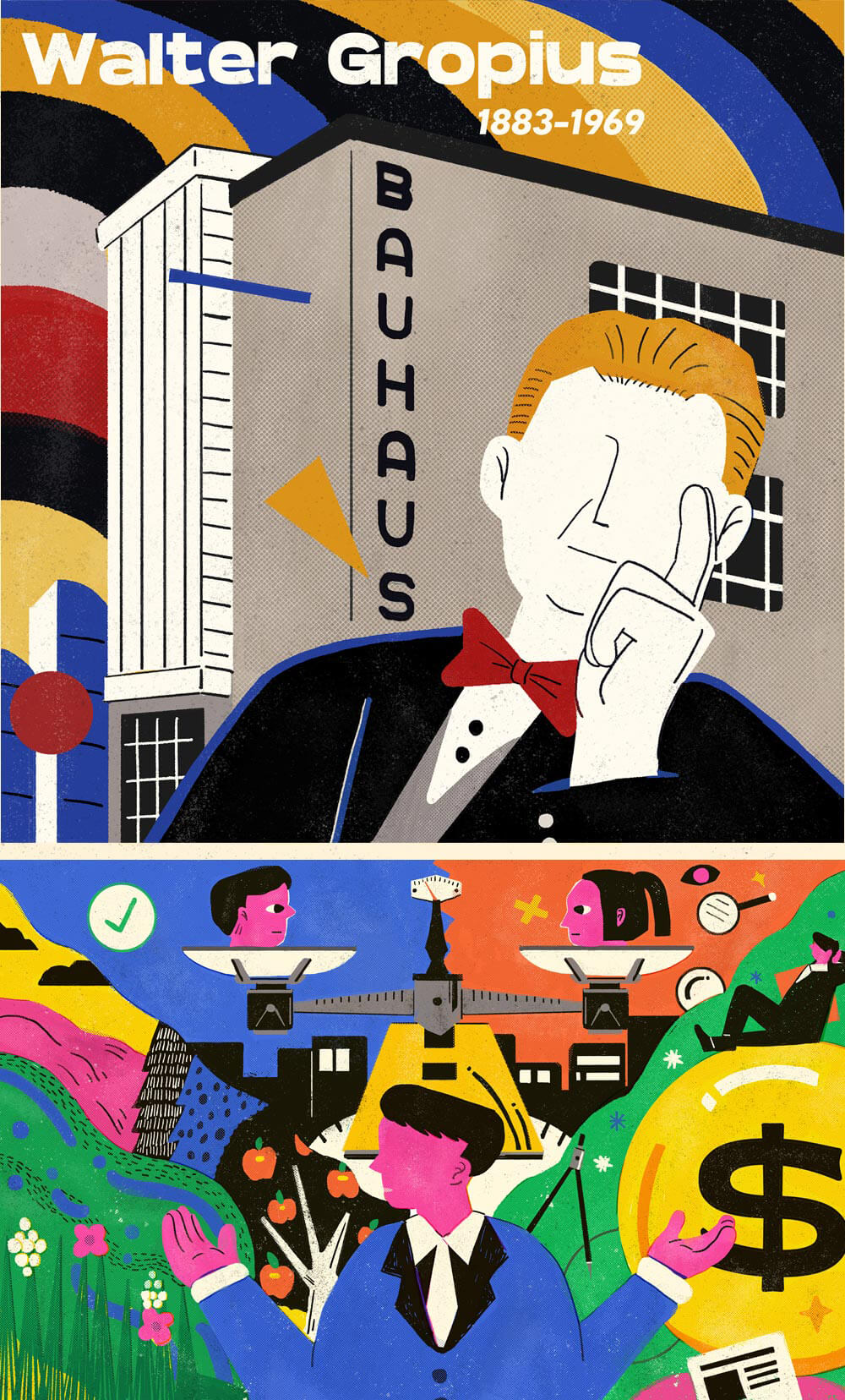Table Of Content

Secondly, Bauhaus architecture was influenced by the artistic and cultural movements of the 1920s, such as expressionism, constructivism, and surrealism. It experimented with new forms of expression, such as collage, photomontage, and typography, and incorporated art, craft, and design elements into its buildings. Bauhaus architects also collaborated with artists, musicians, and dancers to create interdisciplinary works that explored the relationship between space, movement, and sound. Bauhaus architecture was both a functional and practical style and a creative and innovative one. Thirdly, Bauhaus architecture reflected the social and political values of the Weimar Republic, the democratic and progressive state that emerged in Germany after the war.
Joseph Albers
Meyer, who headed up the architecture department, was an active communist, and incorporated his political ideas into student organizations and teaching programs. The school continued to grow in strength, but criticism of Meyer's Marxism grew, and he was dismissed as director in 1930. After local elections brought the Nazis to power in Dessau in 1932, the school was again closed and relocated, this time to Berlin, where it would see out the final year of its existence. Firstly, the Bauhaus structures are often protected by heritage laws that require preserving their original features and materials, which means that any renovation or repair work has to follow strict guidelines and standards, which can increase the cost and time of the project. The Bauhaus Dessau building, designed by Walter Gropius in 1925, underwent a major restoration between 1996 and 2006 that cost about 23 € ($26, £19) million.
Club Chair (Model B (The Wassily Chair)
The United States was a popular destination, becoming home to many Bauhaus icons, including architect Ludwig Mies van der Rohe (the school’s final director before it closed), designer Marcel Breuer, Bauhaus founder Gropius, and artists Josef and Anni Albers. Kerl notes that many of these figures became instructors in U.S. design and architecture schools; László Moholy-Nagy even established the New Bauhaus school in Chicago, known today as the Institute of Design at the Illinois Institute of Technology. Although it’s hard to pin down exactly when and where certain interior design styles originated, for Bauhaus the impetus couldn’t be more clear. The structure of the Bauhaus school broke the boundaries between craftspeople and artists, placing all students in the same workshops where they experimented and learned hands-on, something that was completely unheard of at the time for art students.
Fala Atelier transforms Porto warehouse into "house of many faces"
Whether or not you’re fully aware of the history of the style, what grew out of an unusual art school in Germany has influenced so much of the world that surrounds us today. Below, we unpack the history of the Bauhaus school, the most memorable works to come from it, and how to put its principles into practice within your own home. László Moholy-Nagy traveled to the Netherlands and the UK and then, in 1937, emigrated to the United States. Here he founded the New Bauhaus in Chicago, which continues to exist today as the IIT Institute of Design. Ludwig Mies van der Rohe also taught in Chicago from 1937, as did Ludwig Hilberseimer and Walter Peterhans from 1938, initially at the Armour Institute of Technology, which became the IIT in 1940.
Walter Gropius

The inclusion of sport and physical activity in the Bauhaus curriculum had various purposes. First, as Meyer put it, sport combatted a “one-sided emphasis on brainwork.”[55] In addition, Bauhaus instructors believed that students could better express themselves if they actively experienced the space, rhythms and movements of the body. The Bauhaus approach also considered physical activity an important contributor to wellbeing and community spirit.
Today, nearly every art curriculum includes foundation courses in which, on the Bauhaus model, students learn about the fundamental elements of design. Among the best known of Bauhaus-inspired educational efforts was the achievement of Moholy-Nagy, who founded the New Bauhaus (later renamed the Institute of Design) in Chicago in 1937, the same year in which Gropius was appointed chairman of the Harvard School of Architecture. A year later Mies moved to Chicago to head the department of architecture at the Illinois Institute of Technology (then known as the Armour Institute), and eventually he designed its new campus. The most representative architect of Bauhaus architecture is Walter Gropius, who founded the Bauhaus school in Weimar, Germany, in 1919. He designed iconic buildings that exemplify the Bauhaus style, such as the Bauhaus Dessau, Fagus Factory, and Gropius House.
At the Bauhaus, Music Was More Than a Hobby (Published 2019) - The New York Times
At the Bauhaus, Music Was More Than a Hobby (Published .
Posted: Fri, 06 Sep 2019 07:00:00 GMT [source]
He also influenced many other architects who studied or taught at the Bauhaus, such as Ludwig Mies van der Rohe, Marcel Breuer, and László Moholy-Nagy. Gropius is regarded as a pioneer of modern architecture and a visionary leader of the Bauhaus movement. Gropius called for the school to show a new respect for craft and practical technique, suggesting a return to the attitudes towards art and craft that had characterized the medieval age.
Eight chocolate-brown interiors that look good enough to eat
"You see this all the time in current day, when the parking garage is color-coded to help you remember your floor,” adds Jensen. The basic elements of Bauhaus are primary colors, geometric shapes, angular lines, and functional forms. After all, he was the one who insisted that there should be no distinction between form and function. The Bauhaus design style is marked by the absence of ornamentation and by harmony between the function of an object or a building and its design. Despite only being in existence for 14 years, the Bauhaus took root around the globe and remains arguably the most influential arts and design school in the history of the world.
Skinny Japanese house
At the same time, the simplicity of the design reflects Bayer's interest in enhanced legibility, generating a large amount of negative space between characters, in contrast to the cramped calligraphic scripts of traditional German typography. Describing typography as "human speech translated into what can be read," Bayer wanted written language to have the clarity of speech, and used only lower-case letters for this design since there was no phonetic distinction between upper and lower case. Each character has the same width, meaning that the letters represent interchangeable spaces on the page. The type was therefore extremely easy to work with and could be adapted to typewriter keyboards and typesetting machines. These aspects of the design perfectly sum up the Bauhaus emphasis on functionality and mass producibility. Like Breuer, Bayer was one of the younger members of the Bauhaus's golden generation, born in Austria in 1900.
The same year Mies van der Rohe emigrated to Chicago to become the head of the IIT, designing its campus which was completed in 1958 as well as the iconic Seagram Building in New York City in 1951. Instead, Gropius and other prominent members of the movement left Germany, spreading the ideas of the Bauhaus from Western Europe to the U.S. and Canada to Israel, and turning it into an international movement. Bauhaus developed into the International Style when Gropius, van der Rohe and other prominent members of the Bauhaus emigrated to the U.S. in the 1930s and influenced the development of modernism in the 1950s and 60s.
As the tables’ color-blocked lacquered tops demonstrate, he’d clearly been a master of color for decades. During the turbulent and often dangerous years of World War II, many of the key figures of the Bauhaus emigrated to the United States, where their work and their teaching philosophies influenced generations of young architects and designers. Gropius stepped down as director of the Bauhaus in 1928, succeeded by the architect Hannes Meyer (1889–1954). Meyer maintained the emphasis on mass-producible design and eliminated parts of the curriculum he felt were overly formalist in nature. Additionally, he stressed the social function of architecture and design, favoring concern for the public good rather than private luxury. Following this, most of the students and teachers who had been involved with possibly the most famous and influential school of modernism had to assimilate, go into hiding, or emigrate.
Four years earlier, Josef Albers had been appointed head of the painting programme at the legendary Black Mountain College in North Carolina, where his students included Robert Rauschenberg and Cy Twombly. After his own flight from Germany in 1933, the Jewish-born Hungarian László Moholy-Nagy formed what later became the Institute of Design in Chicago. Albers was appointed to the teaching staff in 1923 before he had even completed his courses at the school. He began in the glass painting workshop and taught furniture design, drawing and lettering. Hannes Meyer, the second director of Bauhaus Dessau, ensured that one day a week was solely devoted to sport and gymnastics.
Thirdly, Bauhaus architecture embraces integrating art and technology and the collaboration of different disciplines and professions. Bauhaus architects worked closely with artists, craftsmen, engineers, and educators to create a holistic and interdisciplinary approach to design. Bauhaus buildings often incorporate elements of painting, sculpture, photography, typography, graphic design, and innovative technologies and techniques, such as prefabrication, modular systems, and mass production. An example of a Bauhaus building that showcases the integration of art and technology is the Bauhaus Archive, designed by Walter Gropius in 1964. Lastly, Bauhaus architecture inspires sustainable and ecological design development and the preservation and restoration of historical and cultural heritage. Bauhaus buildings are designed to be energy-efficient, resource-saving, and environmentally friendly, using natural ventilation, passive solar heating, and renewable materials.

No comments:
Post a Comment